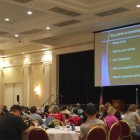
Sep 22, 2015
My trip to Las Vegas for EMS World EXPO 2015 was my eleventh consecutive trip to a major EMS conference. I feel like I have had a front row seat to see the direction that conferences like EMS World EXPO and EMS Today have taken on a number of different levels. The crowd certainly has changed. You still have your big names that show up year after year and those faithful attendees who come year after year and take classes. Many products stay the same, while many “new and great ideas” are here one year, and gone the next. Ambulance design shows the continued utter lack of advancement particularly from a provider safety stand point, which I continue to find alarming. My car today looks nothing like the 1987 Volkswagen Jetta that was my first car in high school, so why does the back of my ambulance look exactly the same as the 1984 box truck that I first road in back in 1993? It is interesting the direction that conferences in general have taken. For a few years there seemed to be a bevy of new content mixed in with the usual trauma, mass casualty and pediatric classes that always seem to populate the convention schedule. We used to learn about how ultrasounds were going to be the next big thing, and now Mobile Integrated Healthcare has taken yet another conference by storm. It’s important information about the future of our industry but come on, folks, it’s time to see something new. To JEMS and EMS World, I beg of you, step outside of your comfort zones. Let’s move away from the same speakers that present year after year, regardless of how many awards that they have won, or how many articles that they have published. We need some fresh new ideas and fresh new presenters. I know that might ruffle the feathers of a few people out there who do not like being turned down, in fact I know of one in particular who has already said he is not submitting to a certain conference anymore because they did not want him this time around, but the time has come. We are...



